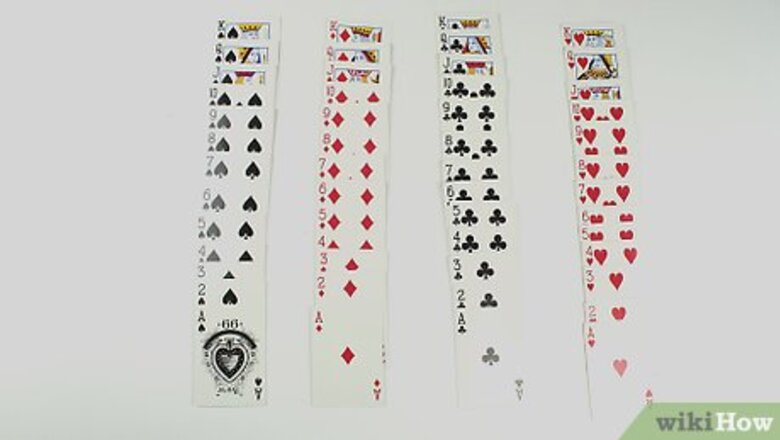
views
Setting Classic Solitaire Up
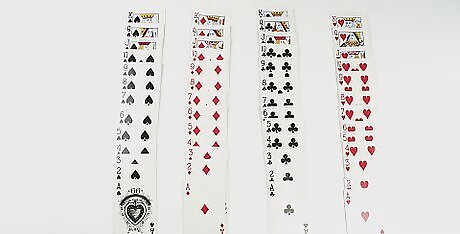
Understand the objective of the game. It is to create four piles of cards - one per suit - in ascending order (beginning with Ace and ending with King). These are called foundation piles. Did You Know? There are a few variations of solitaire, but the most popular version of the game is Klondike Solitaire. This style is so popular that the word "Solitaire" usually refers to the Klondike game rules.
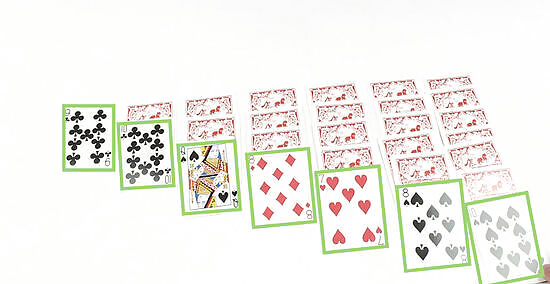
Start building the layout. Put down the first card face up and lay six cards face down next to it. Then, put one card face up on top (but lowered slightly) of the first face down card, then put a face down card on top of the other five cards. Continue doing this, so that each pile has one face up card on top and so that the left pile has one card, the next has two, then three, four, five, six, and finally seven. These piles of cards will become your tableau columns as you play the card game.

Put the remaining cards in a separate pile. Set the pile either above or below the piles. This is your stock pile of cards where you will go to get more cards if you run out of moves.

Leave room at the top for your four foundation piles of cards.
Playing Solitaire
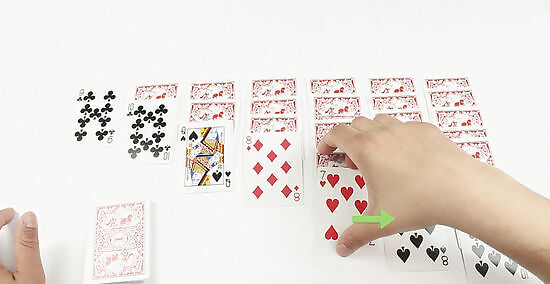
Look at the cards on the table that are face up. If there are any aces, place them above the seven piles to start your foundation piles. If there are no aces, rearrange the cards you have, moving only the face up cards. When you place a card on top (slightly lower so that you can still see both cards), it must be a different color than the card you are placing it on top of and have a value of one less. Thus, if you have a six of hearts, you can either place a five of spades or a five of clubs on top. Keep placing the cards on top of each other until you cannot move anymore. Each pile should be alternating in color and move in descending order.
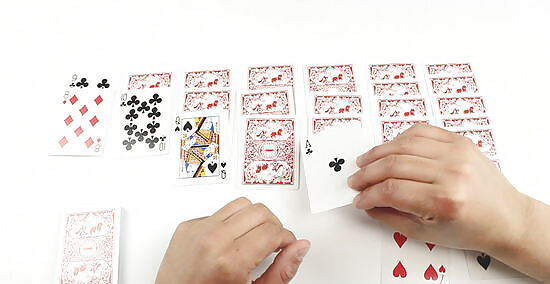
Keep the top card on each stack visible. The card on top of each of the seven tableau columns should be face up. If you move a card, remember to turn the card underneath it over.
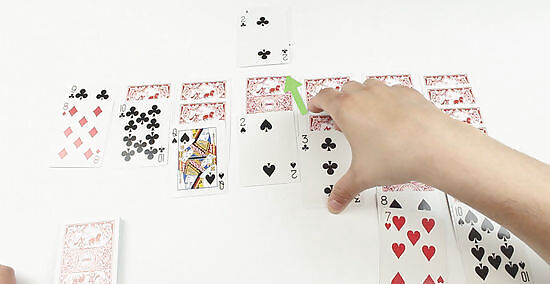
Build your foundation piles starting with the aces. If you have an ace above your cards, (eventually you should have all four aces there), you may move cards of the place cards of the corresponding suit on top of the pile in ascending (A, 2, 3, 4, 5, 6, 7, 8, 9, 10, J, Q, K) order. Each ace will start a different foundation pile. For instance, the ace of spades might start the first pile, and the ace of hearts might start the second pile.
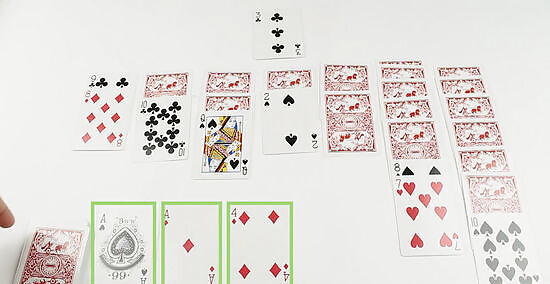
Use the card stock pile if you run out of moves to make. Flip over the top three cards, and see if the top one can be placed anywhere. If you play the first card, see if you can put down the next. If you put down the second card, see if you can put down the last card. Then, if you put down the last card, put down another three cards from the reserve pile. If you cannot make a move with any of these cards, put them in a separate waste pile (taking care not to disturb the order). Repeat until your card stock pile has run out. Once your stock pile runs out, use the waste pile as your reserve. However, make sure that you do not shuffle it!

Uncover hidden cards in the tableau columns during game play. If you have a card that's hidden, you can move cards around until you find places that you can hold and grab the desired card and, eventually, put it in the desired slot.
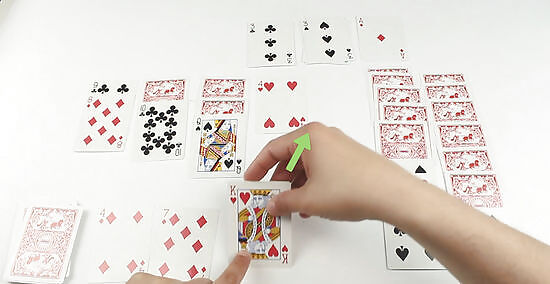
Start a new tableau column in an empty space using a king. If you use all the cards in one of the seven piles, you may place a king (but only a king) in the empty space.
Trying Variations of Solitaire
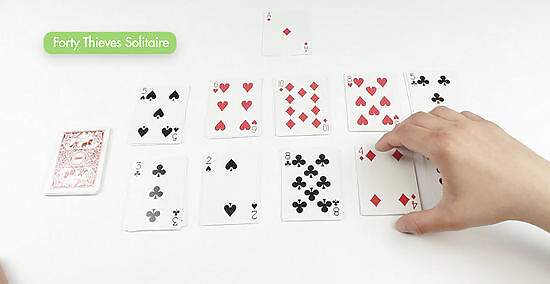
Try playing Forty Thieves solitaire. This version is easier than normal solitaire because you can see the cards in each pile (since they are all face up. The object is still to make a stack for each suit in descending order. When laying out the cards, deal 10 rows of cards with four cards in each pile, all face up. You can only move the top card of each row at a time. There are four spaces above the rows that can be used as holding cells. You can put the top card of one of the rows into a holding cell so that you can get at one of the cards below it. Play the cards in the reserve deck at the same time, but you can only flip one over (not three at a time.)

Try playing Freecell solitaire. This is one of the hardest versions of solitaire. It challenges your skill and mental power more than regular solitaire does because there is no reserve deck to work with. The object is still to make a stack for each suit in descending order. Deal out all of the cards into eight piles--four of the piles should have seven cards in them, and four of the piles should have six cards in them. All of the cards should be face up. Do not use any cards for a reserve deck. All of the cards should be dealt out into the piles. Like Forty Thieves, there are four spaces placed above the rows that are used as reserve spaces. You can only play the top card of each pile, but you can place the top card into one of the reserve spaces so that you can play a card beneath it.
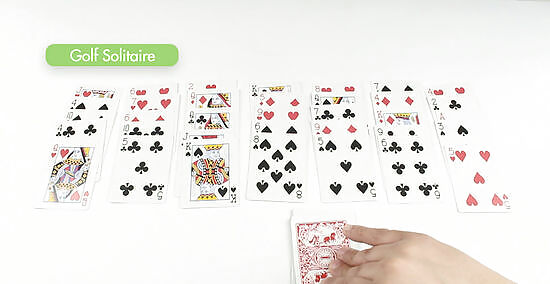
Try playing Golf solitaire. This is a variation of solitaire where the object is to play all of the cards placed face up in the seven piles, rather than create four suit stacks. Deal out seven piles with five cards in each. All of the cards should be face up. All of the other cards should be placed face down in the reserve deck. Flip over the top card of the reserve deck. You will then try to play any of the face up cards from the seven piles on the card you have flipped from the reserve deck. When you cannot play any more cards, flip the next reserve deck card over and play any face up cards you can off of this new card. Continue playing until you have either played all of the face up cards or you cannot make any more moves.
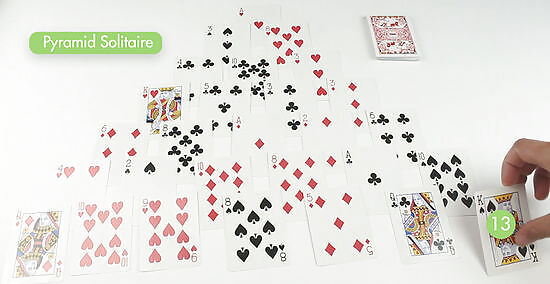
Try playing Pyramid solitaire. The object of the game is to remove all of the cards in the pyramid and reserve pile and place them in the discard pile by creating pairs that equal 13 in point value. Deal out 28 cards into the shape of a pyramid, face up. It should be stacked so that the rows are made of one card, then two cards, then three cards, etc. until all 28 cards have been placed in the pyramid. Each row should overlap the row above it. Note that some people play that you only use 21 cards to make the pyramid. Create a reserve pile with the left over cards. Remove cards one at a time or in pairs. You can only remove cards that have a value of 13. Kings are 13 points, queens 12, jacks 11 and the rest of the cards represent their face values (aces are 1.) For example, you could remove a king; you could also remove an 8 and 5, because they add up to 13. The top card of the reserve deck can also be used to make 13. If no cards can be made into pairs, the next reserve card is flipped over. Once all of the reserve cards have run out, you can take them from the discard pile and return them to the reserve pile so you can keep removing cards from the pyramid.
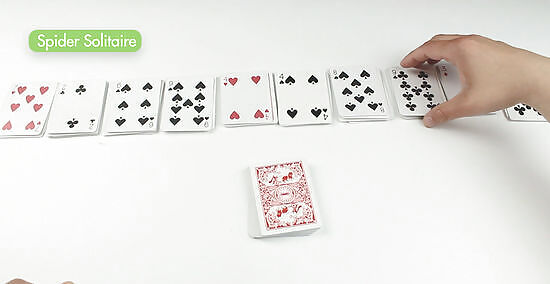
Try playing Spider solitaire. You must use two decks to play spider solitaire. Make 10 piles, four piles should have six cards each, and six piles should have five cards each. Only the top card of each pile should be facing up. The rest of the cards are placed in the reserve deck. The goal is to creating descending card sequences of the same suit from King to Ace within the 10 piles. Once you have completed one descending pile, you can place it in one of the eight foundation squares. You must make a descending order stack eight times. You cannot use the foundation squares as holding spaces for cards. You can create mini stacks (such as 9, 8, 7 of spades) and place them on a 10 of hearts or any other suit while you make other small stacks. The game ends when all eight foundation squares are filled.




















Comments
0 comment